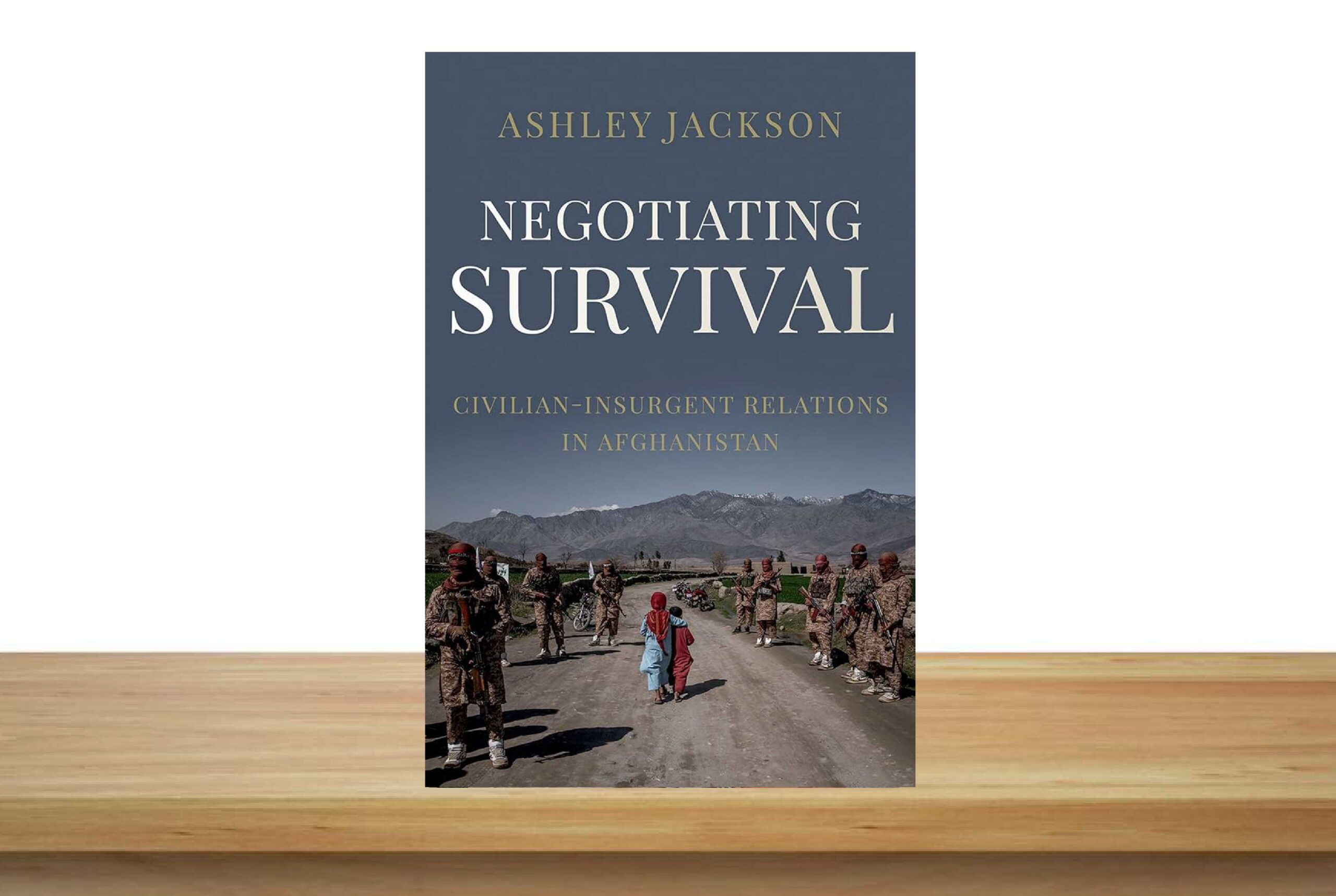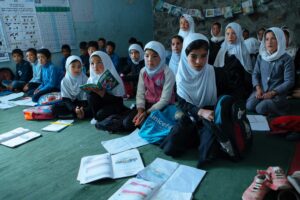
“Negotiating Survival: Civilian-Insurgent Relations in Afghanistan” by Ashley Jackson (Hurst and Co: London, 2021).
In the context of armed conflict, civilians most often cannot decide which authority they want to interact with. When insurgents expand to the detriment of the central government, civilians are “forced to develop different responses, tactics and strategies to survive” (p. 52). At the same time, however, civilians are not completely helpless in the face of insurgency. Betrayal and rebellion against the insurgents are always available but risky options. Therefore, instead of confronting insurgents head-on, civilians tend to bargain with them. Insurgents want civilians to comply with their rule, and they may be prepared to compromise with the population on certain issues if this furthers their security and legitimacy. For both civilians and insurgents, the stakes in this negotiation are high: nothing less than survival is on the line.
In her book “Negotiating Survival: Civilian-Insurgent Relations in Afghanistan”, Ashley Jackson, co-director of the Centre for the Study of Armed Groups at the Overseas Development Institute, makes two major scholarly contributions. Firstly, she furthers our general understanding of how rebel movements and the populations living in the territories under their control engage with each other.
Jackson provides us with a fine-grained analysis of how the general dynamics of civilian-insurgent relations present themselves in the case of Afghanistan during the progressive takeover of the country by the Taliban
Secondly, Jackson provides us with a fine-grained analysis of how the general dynamics of civilian-insurgent relations present themselves in the case of Afghanistan during the progressive takeover of the country by the Taliban during the last decade. Although the author had already carried out field research in Afghanistan in the past, the core of the book consists of more than 400 interviews conducted between July 2017 and February 2019 in fifteen different provinces. Jackson recommends the reader to skip the last pages of the book’s introduction if one is not interested in the nuts and bolts of the author’s methodology. The reader would be choosing this option at his/her own cost because the academician’s methodological discussion is a powerful lesson on how to conduct qualitative research in a conflict area.
“Negotiating Survival” is replete with rich micro-historical evidence. One example of this is the story of Mohibullah, a teenager from the eastern province of Logar who was a successful student before stealing his father’s Kalashnikov and joining the Taliban. Jackson’s fieldwork has most probably helped her in crafting a theoretical approach to civilian-insurgent relations that is deeply aware of the complexities of these interactions. As she explains, combatants and civilians do not belong to completely distinct categories. Their connections are manifold, and the borders between both camps are blurry. Equally important, the author departs from rational actor approaches to conflict. She convincingly argues that emotions motivate individuals to behave in ways cost-benefit analyses would fail to predict. This is the case of Habiba, a headteacher in a girls’ school from Logar who, despite facing death threats and the kidnapping of her husband by the Taliban, has continued to teach her students.
After providing a theoretical overview and a brief account of Afghanistan’s contemporary history, Jackson analyses the Taliban’s interaction with civilians from the viewpoint of the insurgents in the third chapter. Jackson explains that the rebel group deployed violence in a more selective and limited way as their territorial control increased. Around 2014, the Taliban started to have greater political capacity. In Jackson’s own words, “the Taliban went from attacking symbols of the government and foreign occupation to systematically co-opting aid and state-building efforts within a few short years” (p. 103). Although the Taliban leadership did not have a ‘grand plan’ for governance, they gradually took away responsibilities from the Taliban military commanders in the framework of a centralization effort.
The fourth chapter studies the different strategies employed by civilians in their dealings with the Taliban. Jackson distinguishes between customary authorities, civilian organizations such as NGOs or local businesses, and individuals. Whereas the role of customary authorities in Afghanistan has already been skillfully explored by University of Pittsburgh Professor Jennifer Brick Murtazashvili[1], the focus on civilian organizations other than foreign NGOs and individuals is more novel. When it comes to the relations between the Taliban and civilian individuals, the key term is social capital. As Jackson puts it, “for many civilians in Afghanistan, keeping a broad, diverse network or even doing an occasional favour for a Taliban fighter was the best way to navigate insurgent rule” (p. 180).
The Taliban established structures to co-opt civilians and regulate health, education, and taxation.
To a certain extent, the author engages with the burgeoning literature on ‘rebel governance’. Nevertheless, if explored more thoroughly, this strand of literature could have proven more useful to her study. ‘Rebel governance’ emerges when an insurgent organization “gains control over territory that contains civilians and decides to create or encourage civilian structures.”[2] In this sense, the author meticulously describes how the Taliban established structures to co-opt civilians and regulate health, education, and taxation. This behavior can be interpreted as the Taliban acting in the role of ‘rebel rulers’, to use the term coined by City University of New York’s Professor Zacharia Mampilly.[3] Jackson’s framing of Taliban governing practices in the broader theoretical debate on ‘rebel governance’ would facilitate comparative analyses with similar cases, such as the Liberation Tigers of Tamil Eelam (LTTE) in Sri Lanka or the Forces Nouvelles in Côte d’Ivoire[4]. In fact, nothing precludes the researcher from using Jackson’s rich findings to further investigate ‘rebel governance’.
In the uncertain context brought about by the Taliban’s takeover of Kabul in August 2021, the prospects for field research on civilian-Taliban relations appear grim. Jackson might well have been the one turning off the lights for this kind of research in the immediate future. If this is sadly the case, we can at least be glad that “Negotiating Survival” is the work that puts an end to this period. Jackson argues that civilian-insurgent bargaining is fluid because insurgents do not have complete control (p. 222). The question now is how civilians and the Taliban will interact after the insurgents took control of the state machinery. The near future of Afghanistan depends, in large measure, on the answer to this question.
[1] Brick Murtazashvili, Jennifer. Informal Order and the State in Afghanistan. Cambridge: Cambridge University Press, 2016.
[2] Nelson Kasfir, “Rebel Governance–Constructing a Field of Inquiry: Definitions, Scope, Patterns, Order, Causes,” in Rebel Governance in Civil War, edited by Ana Arjona, Nelson Kafsir, and Zachariah Mampilly (Cambridge: Cambridge University Press, 2015), p. 27.
[3] Zachariah Mampilly, Rebel Rulers: Insurgent Governance and Civilian Life during War (Ithaca: Cornell University Press, 2011).
[4] Niels Terpstra and Georg Frerks, “Rebel Governance and Legitimacy: Understanding the Impact of Rebel Legitimation on Civilian Compliance with the LTTE Rule,” Civil Wars 19, no. 3 (2017): 279–307; Förster, Till. “Dialogue Direct: Rebel Governance and Civil Order in Northern Côte d’Ivoire.” In Rebel Governance in Civil War, Edited by Ana Arjona, Nelson Kafsir, and Zachariah Mampilly, pp. 203–25. Cambridge: Cambridge University Press, 2015.

















